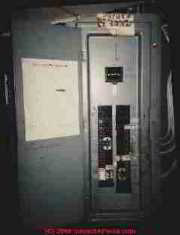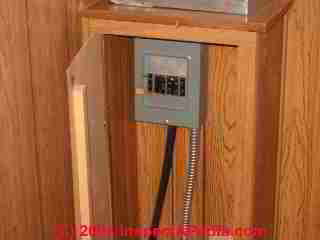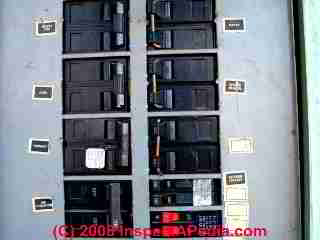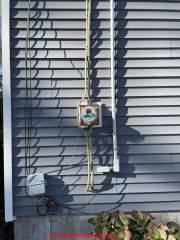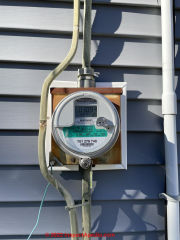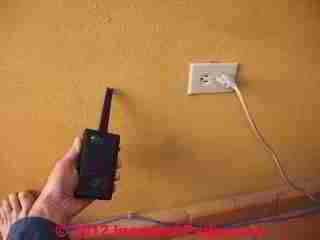 How to Map Electrical Circuits in a Building
How to Map Electrical Circuits in a Building
- POST a QUESTION or COMMENT about how to identify or map individual electrical circuits in buildings
Procedures for mapping building electrical circuits:
Procedure for labeling circuits and fuses in electrical panels. How to find remote, hidden electrical sub panels in a building. Guide to Electrical Hazards in buildings: inspection, detection, & repair advice.
InspectAPedia tolerates no conflicts of interest. We have no relationship with advertisers, products, or services discussed at this website.
- Daniel Friedman, Publisher/Editor/Author - See WHO ARE WE?
Electrical Circuit Identification, Mapping, & Labeling Procedures
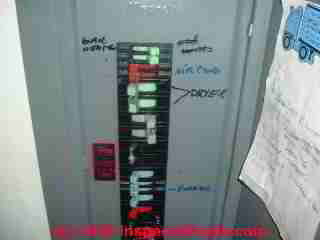 How to Make a Map of the Electrical Circuits in a Building
How to Make a Map of the Electrical Circuits in a Building
Each circuit breaker or fuse on your electrical service panel in a building should be identified to show the area of the building whose circuits it protects. This can be done by putting adhesive-backed paper or plastic stickers next to each circuit breaker or fuse.
Or you can make a sketch of the panel layout with circuits identified, and attach it to or keep it near the service panel. In addition to this, however, a map of your house showing exactly which lights, outlets, appliances, etc., are on each circuit can be a great help in planning electrical work and in tracking down troubles.
If the building is a new home, the builder or electrical contractor may be able to supply you with a copy of his wiring diagram. If you cannot get a circuit map ready-made, you can make your own.
The map you make will probably provide a few surprises. Circuits are often split between rooms-and outlets within a room are split between circuits-in ways you could never have guessed.
Prepare a Building Floor Plan
To start with, draw a floor plan of the building whose circuits you need to trace. Make your floor plan drawing floor-by-floor or room-by-room, whichever is more convenient, but be sure to include every area that has electric service. Include porches, garages, outbuildings, etc.
Use some system of symbols to identify every fixture, wall outlet, and switch. Don't forget outside outlets, entrance lights, outdoor floodlights, etc.
Find the Main Electrical Panel and Find any Sub Panels
Electrical Emergency Response:
One of the most important safety measures to take in a building is to make sure that the adult building occupants know where to shut off electrical power in an emergency
Watch out: If sparks are flying from a toaster or someone is being shocked, we don't want to waste time looking for the electrical panel, nor do we want to waste time figuring out which breaker or fuse to turn off.
In an electrical emergency, go to the main electrical shutoff switch and turn it off. If touching the main switch is unsafe, for example because the floor is wet, you may use a dry non-conductive wooden handle such as a broom to push off or down the power switch.
Find and Label All Main Electrical Shutoff Switches First
The best electrical practice is for a building to have a single, easily accessed, plainly-marked main electrical shutoff switch.
But some buildings, especially older ones, may have no single main power shutoff, and may be powered by multiple electrical panels.
If the main electrical panel serving a building has more than six switches and has no main shutoff switch, we recommend that one be installed.
All main electrical switches (if more than one is present) must be labeled "MAIN" in any building.
In our photo at left the main switch is plainly visible at the top of the electrical panel; an owner has added an arrow and a sign which helped assure that asian occupants of the building would also understand how to turn off all electrical power in an emergency.
How to Find Remote Fuse or Circuit Breaker Panels in a Building
What if you don't know if there are any remote electrical panels or not in a building? Sub panels should be easily found and identified but often they're hidden away such as in this odd panel photo courtesy of Timothy Hemm.
Most simple buildings receive their electrical power through a single electric meter from which the electrical service enters a single main electrical panel.
If this is the case for your building, then if there are additional electrical sub-panels located throughout the building or in outbuildings, most likely each sub panel receives its electrical power from the main panel and there will be a switch in the main panel that controls power to the sub panel.
There are exceptions however: at some buildings electrical power may come from the electric meter into a single main building shutoff which in turn may feed a metal chase or tray to which multiple electrical panels have been connected.
Often these multiple panels are adjacent to one another, but it's certainly possible for an electrical panel to be found in remote spots such as attics, basements, and even hidden in places where an electrical panel should not be located such as in tiny closets or under sinks.
Here are some tips that home inspectors use to guess that a remote electrical panel is present and then to go looking for it:
- If the building is small
and not complex it often has only a single electrical meter and single main electrical panel - Multiple electrical meters:
if the building has multiple electrical meters on its exterior, it's likely that each of these is feeding a main electrical panel, possibly each through a separate main electrical shutoff switch.
In our photo at left one of the electrical meters has been pulled (shutting off power but possibly leaving dangerous live contacts exposed) and all of this electrical installation, which supports knob and tube electrical wiring, is obsolete.
Still, two meters: look for two main panels or two main switches. - Multiple main shutoff switches:
if inside the building where electrical power enters you find multiple switches or boxes labeled "MAIN" then you'll need to find the electrical panels that each of these switches controls.
- Existing electrical panel labels:
if the main electrical panel already has some labels by fuses or switches (as it should) you may see labels indicating "Sub", "Sub Panel", or naming another building area that was perhaps an addition like "Den" or naming an outbuilding like "Garage".
These are areas that may have their own sub panel.
In our photo at left, contributed by a reader, Cheri Jarrett, the red and green double-pole circuit breakers are labeled as "Air Cond" and "Dryer". - If these breakers are still in use for the appliances that have been indicated, they won't be powering sub panels.
Since this is a Zinsco/Sylvania electrical panel we'd recommend that it be replaced for safety.
- Double pole sub panel switches in the main panel: If the main electrical panel contains 240V double pole circuit breakers then the process of determining what each of these switches is for will tell us whether or not there is probably a remote sub panel.
Our photo above, courtesy of Timm Hemm, shows that the common trip ties on some of these double pole breakers are home-made (copper wires at right) and are unsafe.
If we saw a double pole breaker in this panel that was not powering an appliance or similar circuit we'd need to check to see if it was powering a sub panel.
Common devices that use a two-pole 240 V circuit breaker
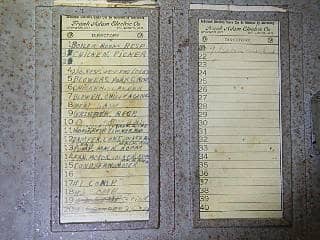 Photo, courtesy of Steve Smallman, shows the labeling of electrical circuits in a 1943 Frrank Adams ™ electrical panel at a property in North Carolina.
Photo, courtesy of Steve Smallman, shows the labeling of electrical circuits in a 1943 Frrank Adams ™ electrical panel at a property in North Carolina.
Circuits included 240VAC circuits for a "Chicken Picker", a "Grinder", a "Condenser Fan Motor" other compressor motors. 120VAC circuits included a meat saw, Chicken Flocker, and other equipment.
[Click to enlarge any image]
- Air compressor motor
- Central air conditioning & heat pumps (typically a double pole breaker ranging from 30A to 50A) )
- Electric water heater (typically a double pole 40A or 50A breaker)
- Electric clothes dryer (typically a double pole 40A breaker)
- Electric oven or stove (typically a double pole 40A or 50A breaker)
- Electric heaters and backup electric heat for heat pump systems
- Multiwire branch circuits (the double pole breaker will be 15A or 20A)
- Steam bath, electric steam generator
- Sub panels: electrical sub panels (may be at any amperage, usually double pole, often 30-A to 60A or even larger)
- Well pumps , some, (typically a double pole 20A breaker)
- Large diameter wires leaving the electrical panel: since most building lighting and receptacle circuits are wired with #14 or #12 gauge wires (15Amp or 20Amp circuits where copper wire is used), if at the electrical panel you see one or more wires that are thicker than their sisters, these may be higher-amp circuits fed by a higher-amp breaker or fuse and possibly connecting to a sub panel.
- Outbuildings: if a property has a detached garage, shop, pool cabana, or other structure which is provided inside with one or more electrical circuits, it's likely that that building is wired from a sub panel located there and fed from the main panel.
You may see overhead wires to an outbuilding, or you may see electrical conduit leaving the outside of the main building and appearing at the exterior of the remote building.
If you see electrical wires or electrical conduit entering a building, look inside the building close to the area where you saw the wire or conduit entering, as that's where you're most likely to find an electrical sub panel. - Building Additions: often when a second floor is added, an attic is converted to living space, or a wing or even a single large room is added to a building the electrician finds it convenient and economical to run a single heavy electrical wire from the main panel to the addition, and to pull the local circuits in the addition all out of a sub panel located there.
Finding Special Power Switches for Major Equipment
In many buildings, for safety as well as service convenience, certain equipment is required to have its own shutoff switch. You should find an electrical shutoff outside at the central air conditioning system compressor/condenser unit, for example, and you may find a separate electrical shutoff switch at an electric water heater.
These shutoff switches may be little electrical sub panels, but normally each of them is simply serving as a local electrical switch - that is, they should not be also powering other electrical circuits.
We don't count these switches as "sub panels" but rather as switches, and the purpose of each will be obvious since it's next to and is connected to the device it serves.
But if you see that someone has added smaller diameter wires coming out of one of these switches, say to add a local electrical outlet or lighting circuit, there's a good chance that the addition is improper and un-safe. That's because we don't want to power a 15-Amp 14-gauge wire receptacle circuit out of a fuse or circuit breaker box that permits 40 or 50 Amps of current to flow (intended for a water heater or electric range).
The result could be a fire. If you suspect that a high-amperage power switch such as we describe has been used to power other electrical circuits you should ask your electrician to check it out promptly.
List the Circuit Breakers or Fuses in Each Electrical Panel
Then number each circuit breaker or fuse on your service panel. If the electrical power in your building is distributed by more than one electrical panel or fuse box, that is, if electrical power is distributed by both a main panel and one or more sub-panels, you'll need to follow this procedure at each electrical panel.
Many homes are served by a single main electrical panel, in which case this task is simple. Find the main electrical panel, open its hinged cover, and look inside at the fuses or circuit breakers.
Most electrical panels have a number embossed on the cover plate next to each circuit breaker. Fuse panels may lack this detail. If your electrical panel face does not have a number by each breaker or fuse, or if they are hard to read, you can use a fine-tipped felt-tipped marker to simply write an identifying number neatly next to each breaker or fuse.
Turn on Lights in the Building
Next, turn on all the ceiling and wall fixtures and lamps in your house. It is not necessary to turn on major appliances at this time.
Turn Off Individual Circuit Breakers or Fuses, One at a Time to Identify Lighting Circuits
The procedure is to turn off each circuit breaker or remove each fuse individually. Then determine which lights are off. Mark the number of the circuit breaker or fuse just turned off or removed next to the fixture and switch symbol on your diagram.
How to Map Electrical Receptacle (Wall Outlet) Circuits
Next check all the wall outlets in the rooms in which lights went out. Plug a small lamp or work light in each outlet. If the lamp does not light, mark the number of the circuit breaker or fuse next to the outlet symbol on your diagram.
Repeat the procedure for each circuit breaker or fuse on your panel. When you finish, every symbol on your floor plan should have a circuit number next to it. If any symbol has been missed, recheck the area by turning on the light or plugging your work light into the outlet. Next, turn off, one at a time, each circuit that your diagram shows on nearby fixtures and outlets until you find the one that applies.
How to Identify Appliance Circuits
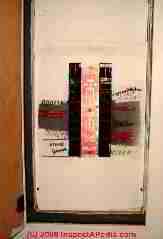 You will find that some of the circuit breakers you have turned off or fuses you have removed have had no effect on lights or outlets.
You will find that some of the circuit breakers you have turned off or fuses you have removed have had no effect on lights or outlets.
These are circuit breakers or fuses that protect large appliance circuits (such as a refrigerator or dishwasher).
Tim Hemm's photo at left shows a poorly labeled electrical panel, and an unsafe-brand (FPE Stab-Lok) that should be replaced. But we can see that someone has thoughtfully labeled some of the circuit breakers as Oven and Addition.
The "Addition" breaker may power a sub panel. But this electrical panel should be replaced, as you can learn in our separate article about Federal Pacific Electric Stab-Lok panels.
Turn off these remaining circuit breakers or remove these fuses one at a time and check your appliances to find out which one does not work.
Remember that furnaces and air conditioners may appear to be off because of temperature-control settings.
Complete the Identifying Notes on the Circuit Map
Be sure to note on your diagram any circuit uses that are not covered by symbols and may be useful to you. For example, two circuit breakers or fuses are used in electric range circuits. Note on your diagrams which device protects the oven and which protects the surface burners.
When you finish your diagram, store it near your service panel in a protective envelope.
Tip: You can save some time and frustration by using a small plug in radio instead of a work light to check the wall outlets. Plug the radio into the outlet you want to check. Tune to a strong station and turn the volume up. Back at the service panel, turn off the circuit breakers or remove fuses one by one. When the sound goes off, you have found the circuit.
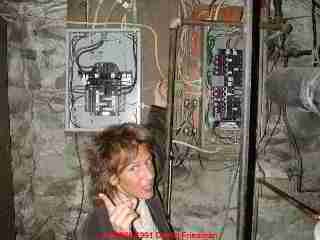
Safety Warning:
Do not attempt to work on your electrical wiring, switches, or outlets unless you are properly trained and equipped to do so. Electrical components in a building can easily cause an electrical shock, burn, or even death.
Even when a hot line switch is off, one terminal on the switch is still connected to the power source. Before doing any work on the switch, the power source must be turned off by setting a circuit breaker to OFF or removing a fuse.
See SAFETY for ELECTRICAL INSPECTORS and ELECTRICAL WIRING BOOKS & GUIDES.
Also see ELECTRICAL CODE BASICS.
Contributors:
- Timothy Hemm, CREIA MCI, ASHI, ICC Certified Inspector, is a professional home inspector in Redlands, California and is a contributor to InspectApedia.com. Mr. Hemm can be contacted at (951)543-3501, timhemm@yahoo.com or tlhinspector@gmail.com , Website: www.homeinspectioninredlandsca.net
- Steve Smallman, Raleigh, NC, Email: steve@stevesmallman.com, Website: http://stevesmallman.com/ Tel: 919-669-3639 - Quoting: Steve Smallman Property Inspections (SSPI) inspectors have performed or supervised over 25,000 inspections since we introduced home inspections to the Triangle area in 1980. Mr. Smallman, located in Raleigh N.C., is a contributor to InspectApedia.com and has commented on or provided information on plumbing traps, electrical wiring, commercial FPE electrical panels and DIY Tests of FPE equipment, roofing underlayment, and building exteriors.
...
Reader Comments, Questions & Answers About The Article Above
Below you will find questions and answers previously posted on this page at its page bottom reader comment box.
Reader Q&A - also see RECOMMENDED ARTICLES & FAQs
On 2021-11-30 by Inspectapedia Com Moderator (mod) - identify wires running outside the home near the electric meter
@J Weiner,
I see lots of wires so I'm not sure which two are the subject of your question
a small extra "ground" wire between the meter base and what's probably a cable entry connector, (rather iffy)
Some co-axial cables, typically phone, TV, interenet
an electrical power wire entering the meter and below it entering the house, typically to a man electrical panel
an unidentified wire running from the same wall location up alongside the meter and up to --- we can't see more -
but often such a wire is running from the electrical panel to an upper-floor device such as an air conditioning system air-handler
an electrical conduit perhaps running wires from a basement electrical panel to an upper floor
and we don't see a grounding electrode, wire, conductor
Recommendation: Follow the wires: inside the home starting at the electrical panel, and look at their destination on the upper floors of the home or in its attic.
On 2021-11-30 by Josephweiner7
What are the 2 wires on this electrical panel?
On 2021-11-30 by J Weiner
What are the 2 wires on this electric meter shown in this picture?
Question: how do I find which outlet is controlled by a switch?
I recently bought a house, which has a energized switch that doesn't control any of the outlets in the room where the switch is located. How can I find the outlet, which is controlled by the single pole switch?
This Q&A were posted originally
at ELECTRICAL DUPLEX RECEPTACLE WIRING
Reply: 4 approaches to tracing a circuit in a building
There are several approaches including
1. figure what the switch would or could have been used for:
either a light fixture (perhaps improperly abandoned and covered up in a ceiling or on a wall - age of building is relevant as is age of wiring and number of generations of wire and types of wire) - giving some places to look (is that odd patch in the ceiling covering over an electrical box that should have been left accessible? is there an attic with accessible junction boxes?)
2. flip breakers off
until the switch loses power, then see what else was on that circuit
3. use a Tic tracer
or other voltage tracer to follow wires in walls and ceilings and floors
See VOLTS / AMPS MEASUREMENT EQUIP
and see TEST EQUIPMENT, ELECTRICAL
4. your local electrician
may have other ideas
Details are in the article above. Please keep me posted on what you find as that'll help other readers.
On 2019-12-22 by (mod) - which breaker controls which circuit
Sure Flanagan,
Some suggestions are at ELECTRICAL CIRCUIT ID, MAP & LABEL
On 2019-12-22 by Flanagan
I am mapping my main panel. I have found SEVEN different circuit breakers that appear to control nothing! I had THREE double pole outlets going nowhere but thanks to this article, I was reminded one of them goes to the Central AC.
It's the dead of winter so I will wait until warmer weather to test which one. I am pretty sure it is the larger, 40amp breaker. I am wanting to do some major re-wiring in my kitchen and install a sub panel, so I really need to know where these breakers go.
Any suggestions? I just spent a solid week and umpteen thousand trips up and down my stairs to map this panel. Interestingly enough, I also found FIVE different old wall outlets, ones I never use, that all tested bad with a circuit tester.
So they are on the list to be repaired. Any suggestions on finding what those seven breakers control?
On 2019-09-14 - by (mod) - right way to identify circuits in blue prints from electrical drop plan on blueprint
W.F.
Circuits are drawn on blueprints showing the circuit general routing and fixtures or devices. Generally the electrician numbers each wire at the home-run end in the electrical panel and if the electrician or installer is not asleep, they should then identify each circuit on the electrical panel cover map.
According to typical US government contract specifying documents, the preferred method of identifying wire and cable construction is by means of a drawing note.
Details are also in
- ELECTRICAL AND ELECTRONICS DIAGRAMS USAS Yl4.l5· 1966 (REAFFIRMED 1973) Sponsor American Society for Engineering Education, The American Society of Mechanical Engineers
On 2019-09-14 by W.f.lenard
To identify circuits in blue prints from electrical drop plan on blueprint s using panel schedule
On 2019-09-04 0 - by (mod) - lost power in part of bedroom
Since there are electrical and safety concerns involved you definitely need an electrician on site.
Common causes of losing half of your power our problem in the electrical panel at self such as a bad electrical connection to the service entry wiring or a bad main breaker. But your electrician will need to sort that out.
On 2019-09-04 by Lauren M Gillie
I just lost electric in half of master bedroom. Hallway bathroom and back bedroom. We checked breaker, switched them, still no power.
On 2019-03-09 - by (mod) - where are double-wide trailer wiring harnesses connected
Typically underneath the home you'll find master plug connectors.
IN some larger homes with an accessible attic the connectors may also be in the attic.
On 2019-03-09 by charles
where do they make the electrical connections to wire the two halves together, in a double wide, bottom or top pf trailer , im trying to find a electrical short
On 2018-11-12 - by (mod) - circuits named on the breaker panel door are wrong
You can either hire an electrician to trace every circuit or you can figure most of it out yourself by switching one circuit off at a time and seeing what goes off in your home. You might need to use a light or radio to check receptacle circuits.
See details of how electrical circuits are traced, mapped, identified in a building
at ELECTRICAL CIRCUIT ID, MAP & LABEL
On 2018-11-12 by Kenneth
The previous owners of the town home er live in did not make a accurate listing of the numbers on the circuit breaker,and I need to correct it.
On 2018-08-07 - by (mod) -
Probably an open wire somewhere in the circuit.
It is common in many countries to wire electrical receptacles in series - so if a connection fails early in the circuit everything downstream is "off".
Your electrician will start by checking conditions in the electrical panel, then trace the relevant circuits forward from there.
On 2018-08-07 by martin schultz
no power to switches or outlets in living room. breaker is not tripped. why no power?
...
Continue reading at ELECTRICAL TOOLS & TESTS or select a topic from the closely-related articles below, or see the complete ARTICLE INDEX.
Or see ELECTRIAL CIRCUIT ID, MAP & LABEL FAQs - questions & answers about how to identify which wires do what in a building, posted originally at the end of this page.
Or see these
Recommended Articles
- ELECTRICAL CIRCUIT ID, MAP & LABEL
- ELECTRICAL DISTRIBUTION PANELS - common defects found by visual inspection
- ELECTRIC PANEL AMPACITY
- ELECTRICAL PANEL COVER SCREWS
- ELECTRIC PANEL INSPECTION - home
- ELECTRIC PANEL WORKING SPACE
- ELECTRICAL TOOLS & TESTS
- VOLTS / AMPS MEASUREMENT EQUIP
- TEST EQUIPMENT, ELECTRICAL
Suggested citation for this web page
ELECTRICAL CIRCUIT ID, MAP & LABEL at InspectApedia.com - online encyclopedia of building & environmental inspection, testing, diagnosis, repair, & problem prevention advice.
Or see this
INDEX to RELATED ARTICLES: ARTICLE INDEX to ELECTRICAL INSPECTION & TESTING
Or use the SEARCH BOX found below to Ask a Question or Search InspectApedia
Ask a Question or Search InspectApedia
Try the search box just below, or if you prefer, post a question or comment in the Comments box below and we will respond promptly.
Search the InspectApedia website
Note: appearance of your Comment below may be delayed: if your comment contains an image, photograph, web link, or text that looks to the software as if it might be a web link, your posting will appear after it has been approved by a moderator. Apologies for the delay.
Only one image can be added per comment but you can post as many comments, and therefore images, as you like.
You will not receive a notification when a response to your question has been posted.
Please bookmark this page to make it easy for you to check back for our response.
IF above you see "Comment Form is loading comments..." then COMMENT BOX - countable.ca / bawkbox.com IS NOT WORKING.
In any case you are welcome to send an email directly to us at InspectApedia.com at editor@inspectApedia.com
We'll reply to you directly. Please help us help you by noting, in your email, the URL of the InspectApedia page where you wanted to comment.
Citations & References
In addition to any citations in the article above, a full list is available on request.
- Mark Cramer Inspection Services Mark Cramer, Tampa Florida, Mr. Cramer is a past president of ASHI, the American Society of Home Inspectors and is a Florida home inspector and home inspection educator. Mr. Cramer serves on the ASHI Home Inspection Standards. Contact Mark Cramer at: 727-595-4211 mark@BestTampaInspector.com
- John Cranor [Website: /www.house-whisperer.com ] is an ASHI member and a home inspector (The House Whisperer) is located in Glen Allen, VA 23060. He is also a contributor to InspectApedia.com in several technical areas such as plumbing and appliances (dryer vents). Contact Mr. Cranor at 804-873-8534 or by Email: johncranor@verizon.net
- Timothy Hemm has provided photographs of various electrical defects used at the InspectAPedia TM Website. Mr. Hemm is a professional electrical inspector in Yucala, CA.
- NFPA - the National Fire Protection Association can be found online at www.nfpa.org
- The 2008 NEC National Electrical Code (ISBN 978-0877657903) Online Access LINK (you'll need to sign in as a professional or as a visitor)
- "Electrical System Inspection Basics," Richard C. Wolcott, ASHI 8th Annual Education Conference, Boston 1985.
- "Simplified Electrical Wiring," Sears, Roebuck and Co., 15705 (F5428) Rev. 4-77 1977 [Lots of sketches of older-type service panels.]
- "How to plan and install electric wiring for homes, farms, garages, shops," Montgomery Ward Co., 83-850.
- "Simplified Electrical Wiring," Sears, Roebuck and Co., 15705 (F5428) Rev. 4-77 1977 [Lots of sketches of older-type service panels.]
- "Home Wiring Inspection," Roswell W. Ard, Rodale's New Shelter, July/August, 1985 p. 35-40.
- "Evaluating Wiring in Older Minnesota Homes," Agricultural Extension Service, University of Minnesota, St. Paul, Minnesota 55108.
- In addition to citations & references found in this article, see the research citations given at the end of the related articles found at our suggested
CONTINUE READING or RECOMMENDED ARTICLES.
- Carson, Dunlop & Associates Ltd., 120 Carlton Street Suite 407, Toronto ON M5A 4K2. Tel: (416) 964-9415 1-800-268-7070 Email: info@carsondunlop.com. Alan Carson is a past president of ASHI, the American Society of Home Inspectors.
Thanks to Alan Carson and Bob Dunlop, for permission for InspectAPedia to use text excerpts from The HOME REFERENCE BOOK - the Encyclopedia of Homes and to use illustrations from The ILLUSTRATED HOME .
Carson Dunlop Associates provides extensive home inspection education and report writing material. In gratitude we provide links to tsome Carson Dunlop Associates products and services.


